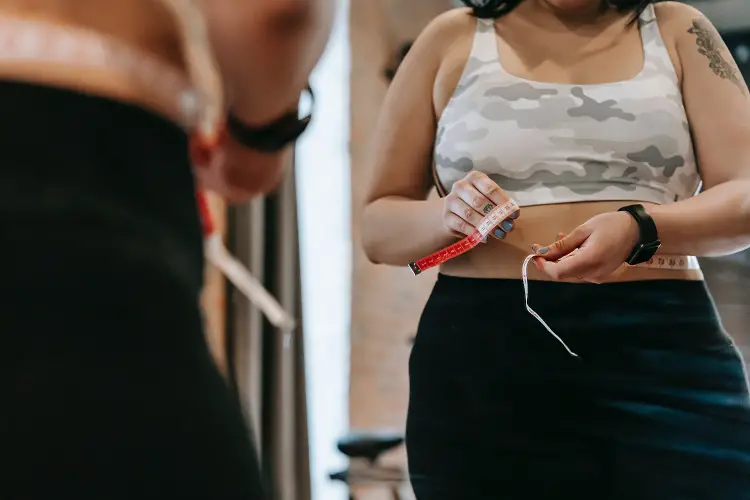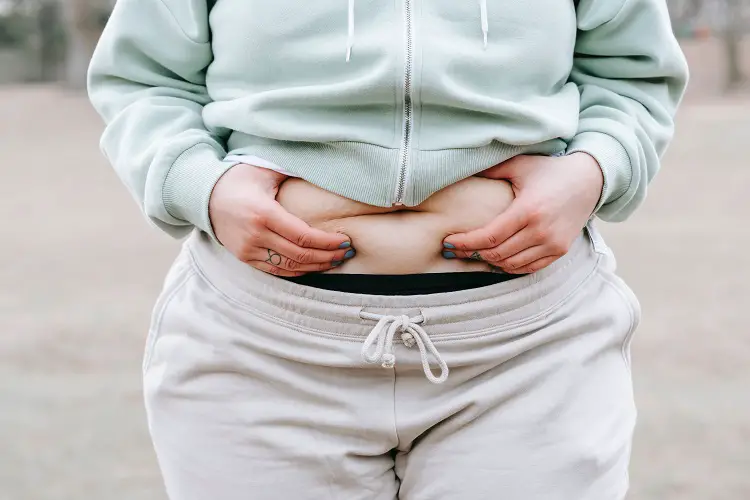The decision to breastfeed your little one can be a healthy thing for you and your baby, but usually, it can complicate your attempts to lose weight, especially the unsightly belly fat.
Postpartum belly fat is one area most new mothers want to lose weight, but sometimes it can feel like it will never go away.
Not getting enough sleep and feeling like you cannot leave your baby for long periods can make exercise seem impossible and may also create the urge to eat.
However, the right fitness and eating proper, nutritious calories will help drop the unhealthy belly fat and keep up your milk supply.
In this article, we discuss some easy yet very effective tips on how to lose belly fat while breastfeeding.
How To Keep Up Your Milk Supply While Losing Weight
Keeping up your milk supply while losing weight can be a daunting task, but it’s possible! You can begin by using galactagogues and supply-boosters to boost healthy lactation.
Here is useful information on the specific supplements that work, and of course, this protein powder has a unique blend that will help breast milk production.
Here are some practical tips that will help encourage your body to produce more milk as you transition your diet for weight loss:
1. Increase Your Feeding
An increase in feeding increases milk production. By increasing the demand, you can increase your supply before you start seeing any impact from diet.
This boosts your supply to help mitigate and decrease what might happen when there’s a change in your diet, calories, and nutrients.
2. Include More Pumping Sessions
Pumping your breast milk more is usually the same as feeding more, but adding more feedings doesn’t always work with work and schedules. It’s not the time a baby wants to feed more, so you can use the pump instead.
3. Wear Baby More Often
Wearing your baby can add more skin-to-skin contact. This trick increases the pheromones that help produce oxytocin for lactation. By wearing your baby more often, or even co-sleeping, you help stimulate these chemicals.
4. Use Milk-Supply Boosters
Using supply boosters like this protein powder or lactation bars, as well as some teas or supplements, can help keep hormone levels stable and increase milk production.
Fenugreek is one beneficial supplement that we use in our formula, and many moms have had success with it in increasing milk supply.
Read Also: How To Refill Your Breast Milk Faster (10 Helpful Tips)
How To Lose Belly Fat While Breastfeeding: 7 Effective Steps

Step 1: Be Patient
Firstly, don’t feel pressured to wean to lose belly fat quickly try and stay patient. Changing your diet and habits is a difficult thing to do.
Human beings are habitual creatures by nature, so once we develop habits that make us feel good, like tasty food, it is always difficult to stop.
Most especially when the food you switched to is not as yummy. Begin switching to healthy food that tastes great (this powder!) and is nourishing.
You can be on the right track to make changes! Just start with small changes. Substituting that one meal can be a small step with a big impact.
Step 2: Aim For Gradual Weight Loss
Have a proper plan, like taking at least 10 months to return to your pre-pregnancy weight. Avoid taking any weight loss efforts in the first six weeks, as calorie restriction may affect milk production. Adjust your caloric consumption to lose about 1 pound, and at most, 2 pounds per week.
Step 3: Eat Whole Grains Instead Of Refined Flours
A study published by Pennsylvania State University in the 2008 issue of the “American Journal of Clinical Nutrition” stated, consuming whole grains (like whole-grain bread, brown rice, quinoa, and oatmeal) instead of refined grains while following a lower calorie diet encourages weight loss in the belly.
Consuming whole grains helps provide a bonus of filling fiber, which assists with postpartum irregularity. Also, try consuming foods like nuts that are high in fiber and monounsaturated fats instead of snack crackers and cookies.
According to a study in the journal “Diabetes Care” in 2007, Cook with olive or canola oil because the inclusion of monounsaturated fats in place of saturated fats reduces fat in the belly.
Step 4: Focus On Nutrient-Dense Foods
It’s important to focus on nutrient-dense foods while breastfeeding. Nutrient-dense foods are foods that have a lot of nutrients per calorie, for example, fruits and vegetables.
These foods are low in calories, high in nutrients, and can take a lot of stress out of the weight loss process while breastfeeding. Some good nutrient-dense foods included in our powder are:
- Chia Seeds, Flax Seeds, Pumpkin Seeds
- Spinach + Kale
- Apples
- Berries
- Sweet Potatoes
- Oatmeal
- Avocados
Step 5: Walk More Often for 45 Minutes At A Time
Walking can be a great, free, and easy way to help your body burn fat. If you raise your heart rate a little, but not as much as running, you tend to keep your body in a fat-burning zone.
A study shown in the University of Illinois American Journal of Physiology, Endocrinology, and Metabolism published in 2009 says, “Cardiovascular exercise will not affect your milk supply and will help target belly fat.”
Fortunately, walking around the park with a baby isn’t that difficult, especially if you wear them and go for a walk. Most babies love to be worn and carried around, so this makes both the mom and baby happy.
Some babies behave well in a stroller, depending on their age. By adding this walking program to your daily routine, you will add some fat-burning activities to help burn off that belly fat.
Step 6: Don’t Start Practicing Any Bunch Of Crunches!
Be aware that Ab exercises are not going to help burn your belly fat. Eating right, walking, and ultimately burning more calories than you are consuming is going to go a long way in getting rid of your belly fat and extra weight all over.
However, you can practice some ab-healing exercises to help with muscle repair after pregnancy. Trying to close the gap between your ab muscles will, in turn, help your abs return to normal after pregnancy.
Step 7: Practice Intermittent Fasting While Breastfeeding
Practicing intermittent fasting can be a great way to burn fat because it helps your body use fat as fuel. By fasting for 12-16 hours, your body has to utilize stored fat once the glucose is used.
When you combine this act with a nutrient-dense diet, you can lose weight, but still nourish your body for breastfeeding. Intermittent fasting can also play a huge role in appetite control and cravings, which are so common while breastfeeding.
Tip:
Bring your husband/partner on board with your weight loss journey, let him help you prepare healthy meals, and support your efforts to exercise.
Warning:
When trying to lose belly fat, be careful not to lose weight too quickly because fast weight loss (more than 2 lbs. per week) may lead you to release toxins into your bloodstream and affect your breast milk.
Losing belly fat is just one part of feeling like “you” again. If you’re also craving deeper connection with your partner, I’ve got you covered. My ebook “Reigniting Intimacy After Baby” is full of simple ways to rebuild closeness, confidence, and affection in the postpartum season. Get your copy here for both Kindle and paperback.
Related Posts:
- 5-Minute High-Volume Dinners for Weight Loss
- 7 Yoga Exercises to Reduce Belly Fat After C-Section
- How Long To Use an Abdominal Binder After C-Section
- Breastfeeding Tips For First-Time Mothers
- Fasting During Breastfeeding (5 Healthy Tips To Help You Cope)
Foods To Avoid While Breastfeeding
These are some foods that health experts advise limiting to support losing weight while breastfeeding:
- Snack foods with empty calories, such as chips, candy, and soda.
- Sugary foods have been shown to contribute to inflammation.
- Alcohol, when in large amounts through breast milk
- could impair a baby’s development.
Rather than consuming any of these foods, try to stock up on these food groups while breastfeeding to help get your body back on track and keep your breast milk as nutritious as possible:
- Fruits, vegetables, and grains for vital minerals and vitamins. Detroyer recommends whole wheat, rye, quinoa, millet, and farro.
- Starches provide energy to assist your body in milk production. For example, winter squash, beans, potatoes, pasta, and rice.
- Lean protein from meat, fish, and nuts helps build and repair worn-out body tissue.
- The food you consume does not influence how much fat ends up in your milk, but it does impact the type. Foods like nuts, eggs, olive oil, cheese, avocados, and seeds help provide a good balance of monounsaturated and omega-3 fatty acids, which are very important for a newborn’s brain development.
- Breast milk is about 88 percent water, but you don’t have to gulp water constantly to stay hydrated (and drinking excess water won’t produce more milk). Just drink water when you’re thirsty and always keep a close eye on the color of your urine. If the color is dark, you need to drink more fluids.
Conclusion
I hope this article has given an in-depth discussion to answer the question of how to lose belly fat while breastfeeding. However, having the right information will help you determine how best to take care of your body.
Remember, to bring your partner on board on the journey, allow him to be involved, and encourage your weight loss goal. Also, be patient during this journey, and try not to lose weight too quickly. Fast weight loss (more than 2 lbs. per week) may lead you to release toxins into your bloodstream and affect your breast milk.
